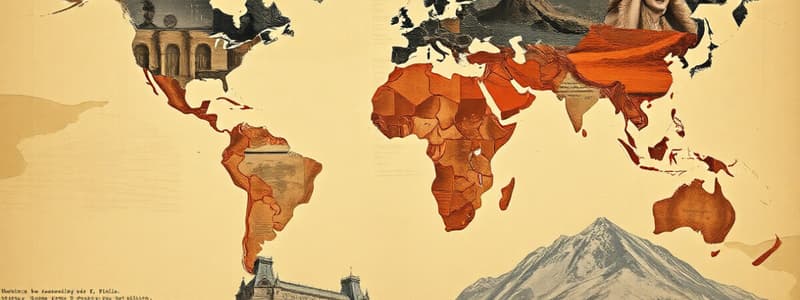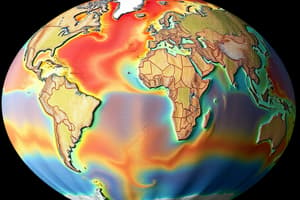Podcast
Questions and Answers
Who is credited with initially proposing the idea of continental drift as an explanation for the fit of the continents?
Who is credited with initially proposing the idea of continental drift as an explanation for the fit of the continents?
- James Hutton
- Arthur Holmes
- Abraham Ortelius (correct)
- Alfred Wegener
What does the Continental Drift Theory primarily explain?
What does the Continental Drift Theory primarily explain?
- The formation of mountain ranges due to volcanic activity.
- The cyclical changes in Earth's climate zones and ice ages.
- The process of erosion and sediment deposition in river deltas.
- The movement of Earth's continents relative to each other over geological time. (correct)
What evidence did Wegener use to support the theory of continental drift, based on topographical fit?
What evidence did Wegener use to support the theory of continental drift, based on topographical fit?
- The patterns of ocean currents and their effect on coastal erosion.
- The distribution of coral reefs in tropical regions.
- The alignment of magnetic minerals in ancient rocks.
- The matching shapes of coastlines on different continents. (correct)
Which term refers to the supercontinent that existed approximately 225 million years ago?
Which term refers to the supercontinent that existed approximately 225 million years ago?
What is the significance of finding fossils of the Mesosaurus on both the continents of South America and Africa?
What is the significance of finding fossils of the Mesosaurus on both the continents of South America and Africa?
Identical rock patterns found in the southern hemisphere continents are known as what?
Identical rock patterns found in the southern hemisphere continents are known as what?
The Appalachian Mountains share similarities with mountains in which of the following regions?
The Appalachian Mountains share similarities with mountains in which of the following regions?
What paleoclimatic evidence did Wegener use to support his theory of continental drift?
What paleoclimatic evidence did Wegener use to support his theory of continental drift?
Fossils consisting of tropical plants are found in the form of coal deposits on which continent?
Fossils consisting of tropical plants are found in the form of coal deposits on which continent?
According to the theory of continental drift, which ocean was located between Laurasia and Gondwana?
According to the theory of continental drift, which ocean was located between Laurasia and Gondwana?
What critical evidence supporting continental drift was not available to Alfred Wegener during his time?
What critical evidence supporting continental drift was not available to Alfred Wegener during his time?
What is one implication of understanding continental drift for modern geology?
What is one implication of understanding continental drift for modern geology?
Which of the following is the most accurate description of how continents move according to the theory of continental drift?
Which of the following is the most accurate description of how continents move according to the theory of continental drift?
What was the primary reason for the initial widespread rejection of Wegener's continental drift theory?
What was the primary reason for the initial widespread rejection of Wegener's continental drift theory?
How does the concept of "Fossil Correlation" support the theory of Continental Drift?
How does the concept of "Fossil Correlation" support the theory of Continental Drift?
What would be the most likely effect on global geography if continental drift were to stop completely?
What would be the most likely effect on global geography if continental drift were to stop completely?
Which of the following best describes the relationship between continental drift and plate tectonics?
Which of the following best describes the relationship between continental drift and plate tectonics?
How did the discovery of the mid-Atlantic ridge contribute to the understanding of continental drift?
How did the discovery of the mid-Atlantic ridge contribute to the understanding of continental drift?
What does the distribution of Glossopteris fossils across continents like Antarctica, Australia, and India suggest about their past?
What does the distribution of Glossopteris fossils across continents like Antarctica, Australia, and India suggest about their past?
What role do magnetic stripes on the ocean floor play in supporting the theory of continental drift and plate tectonics?
What role do magnetic stripes on the ocean floor play in supporting the theory of continental drift and plate tectonics?
How does the presence of similar coal deposits in both Europe and North America provide evidence for continental drift?
How does the presence of similar coal deposits in both Europe and North America provide evidence for continental drift?
Which of the following geological features provides the strongest evidence for past continental connections due to matching rock formations?
Which of the following geological features provides the strongest evidence for past continental connections due to matching rock formations?
The existence of similar species of flightless birds like rheas in South America and emus in Australia but nowhere else is evidence for which concept?
The existence of similar species of flightless birds like rheas in South America and emus in Australia but nowhere else is evidence for which concept?
What impact does continental drift have on the distribution of earthquakes and volcanoes?
What impact does continental drift have on the distribution of earthquakes and volcanoes?
Which of the following describes a key difference between the supercontinents Pangaea and Gondwana?
Which of the following describes a key difference between the supercontinents Pangaea and Gondwana?
What can be inferred about the future positions of continents based on current continental drift patterns?
What can be inferred about the future positions of continents based on current continental drift patterns?
How does the study of paleomagnetism contribute to our understanding of continental drift?
How does the study of paleomagnetism contribute to our understanding of continental drift?
Flashcards
Continental Drift Theory
Continental Drift Theory
The theory that Earth's continents have moved relative to each other over geological time.
Abraham Ortelius
Abraham Ortelius
A Brabantian cartographer and geographer who created the first modern atlas, 'Theatrum Orbis Terrarum'.
Alfred Wegener
Alfred Wegener
German meteorologist who fully developed the continental drift theory.
Pangaea
Pangaea
Signup and view all the flashcards
Topographic Evidence
Topographic Evidence
Signup and view all the flashcards
Fossils
Fossils
Signup and view all the flashcards
Mesosaurus
Mesosaurus
Signup and view all the flashcards
Gondwana Sequence
Gondwana Sequence
Signup and view all the flashcards
Paleoclimatic Evidence
Paleoclimatic Evidence
Signup and view all the flashcards
Study Notes
- The notes cover continental drift theory and the evidence supporting it
Continental Drift Theory
- This theory describes the movement of Earth's continents relative to each other
- This movement makes them appear to "drift" across the ocean bed
Proposing Continental Drift
- Abraham Ortelius, a Brabantian cartographer and geographer, proposed the continental drift theory
- Ortelius created the first modern atlas, titled Theatrum Orbis Terrarum
Developing Continental Drift
- Alfred Wegener, a German meteorologist, fully developed the Continental Drift Theory
Continental Positions Over Time
- Pangea existed 225 million years ago during the Permian Period
- Laurasia and Gondwana existed 200 million years ago during the Triassic Period
- Continents moved to current positions 65 million years ago during the Cretaceous Period
Wegener's Evidence
- Topographic Evidence
- Fossil Correlation
- Rock Formation
- Paleoclimatic Evidence
Topographic Evidence
- The "good fit" of continents suggests they were once connected, similar to jigsaw puzzle pieces, forming a supercontinent
Fossil Correlation
- Fossils are the traces and remains of prehistoric organisms
- Remains of Mesosaurus are an example of Wegener's evidence
Rock Formation
- Rocks and fossils in the southern hemisphere continents exhibit an identical pattern known as the "Gondwana Sequence"
- The Appalachian Mountains in the United States are similar to those in Greenland and Europe
Paleoclimatic Evidence
- Glacial till deposits in northern and southern latitudes are evidence to support continental drift
- The discovery of tropical plant fossils in the form of coal deposits in Antarctica is further evidence
- Antarctica was possibly closer to the equator, where the climate is warmer, to account for the tropical plant fossils
Continents Ranked by Population
- Asia has the largest population as of 2023-2024, with 4,753,079,726 people
- Africa has the second largest population, with 1,460,481,772 people
- Europe has a population of 740,433,713
- North America has a population of 604,182,517
- South America has a population of 439,719,009
- Australia/Oceania has a population of 46,004,866
- Antarctica has no permanent population
Continents Ranked by Area
- Asia has the largest area at 31,033,131 Km2
- Africa, with 29,648,481 Km2
- Antarctica, with 13,720,000 Km2
- North America, with 21,330,000 Km2
- Europe, with 22,134,710 Km2
- South America, with 17,461,112 Km2
- Australia/Oceania has the area of 8,486,460 Km2
Continents Ranked by Density
- Asia has the highest density at 153 P/Km2
- Africa has a density of 49 P/Km2
- Europe has a density of 33 P/Km2
- North America has a density of 28 P/Km2
- South America has a density of 25 P/Km2
- Australia/Oceania has a density of 5 P/Km2
- Antarctica has a density of 0 P/Km2
Largest Asian Countries
- India has a population of 1,428,627,663, and a land area of 2,973,1903 Km2
- China has a population of 1,425,671,352 and a land area of 9,388,211 Km2
- Indonesia has a population of 277,534,122 and a land area of 1,811,570 Km2
Largest African Countries
- Nigeria has a population of 223,804,632, and a land area of 910,770 Km2
- Ethiopia has a population of 126,527,060 and a land area of 1,000,000 Km2
- Egypt has a population of 112,716,598 and a land area of 995,450 Km2
Largest North American Countries
- The U.S.A has a population of 339,996,563, and a land area of 9,147,420 Km2
- Mexico has a population of 128,455,567 and a land area of 1,943,950 Km2
- Canada has a population of 38,781,291 and a land area of 9,093,510 Km2
Largest South American Countries
- Brazil has a population of 216,422,446, and a land area of 8,358,140 Km2
- Colombia has a population of 52,085,168 and a land area of 1,109,500 Km2
- Argentina has a population of 45,773,884 and a land area of 2,736,690 Km2
Largest European Countries
- Russia has a population of 144,444,359, and a land area of 16,376,870 Km2
- Germany has a population of 83,294,633 and a land area of 348,560 Km2
- The United Kingdom has a population of 67,736,802 and a land area of 241,930 Km2
Largest Australia/Oceania Countries
- Australia has a population of 26,439,111, and a land area of 7,682,300 Km2
- Papua New Guinea has a population of 10,329,931 and a land area of 452,860 Km2
- New Zealand has a population of 5,228,100 and a land area of 263,310 Km2
Studying That Suits You
Use AI to generate personalized quizzes and flashcards to suit your learning preferences.




